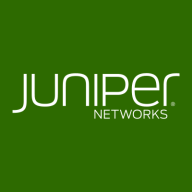

Meraki MS Switches and Juniper QFX Series Switches are contenders in the network switches category. Meraki holds an advantage with its easy-to-use cloud management platform.
Features: Meraki MS Switches provide cloud management with a centralized dashboard, simplifying configuration and remote management. Quick deployment and cloud-based firmware updates are also included. Juniper QFX Series Switches offer high port density, VxLAN, and EVPN functionalities, enhanced by Broadcom chipsets for superior performance.
Room for Improvement: Meraki Switches are seen as costly, with users desiring offline functionalities to reduce cloud reliance. Juniper Switches need improvements in GUI simplicity, better support for fiber connectivity, and smoother upgrade processes. Both products could benefit from more competitive pricing strategies.
Ease of Deployment and Customer Service: Meraki supports flexible deployment models and simplifies the process via its cloud-based management, though there are inconsistencies in technical support response times. Juniper focuses on on-premises deployments and excels in customer service, offering quick and efficient technical support.
Pricing and ROI: Meraki's high pricing is offset by integrated features and scalability, though costs can vary based on cloud usage. Juniper, while expensive upfront, offers competitive pricing compared to high-end rivals and delivers consistent scalability, justifying its investment.
Other brands might break after three or four years, but with Juniper, I can use it until now, around nine years, and it's still very usable and very stable.
The normal ROI customers work with is five years unless there is a major change in technology.
The technical support of Juniper is very helpful because if we have some big issues, we can raise P1 or P2 tickets, and the response from Juniper is very fast.
Sometimes parts are not available in stock, then you have to wait for replacement time.
The support is excellent and rated ten out of ten.
If the devices are licensed, the support team will assist you depending on the severity level of the case.
Cisco's tech support is pretty good, and I would rate it an eight out of ten.
For any kind of environment, this scalability is extensive.
They're quite scalable for my environment.
Juniper has better performance than any other networking product as far as performance is concerned in the router area.
If something happens to the device or hardware, Cisco will automatically change the device by the next business day.
We faced issues following firmware updates, which we now handle by performing updates outside of working hours.
My personal opinion is that if anyone wants to work with a Layer 3 fabric in a data center, they should choose Juniper because working with ACI and APIC is very complex in the Cisco part.
I would like to see other cheaper plans for the license on the QFX series.
Meraki should also consider improvements in stacking features, particularly in the lower-end models like NS130, where stacking isn't supported, unlike with Cisco traditional switching.
When a switch disconnects from the internet, you can't make any changes to that switch.
There are compatibility issues with certain Power over Ethernet (PoE) devices, which we would like to see resolved.
We are a number one, tier-one partner of Juniper. Therefore, we normally get better discounts than with Cisco because we don't have the level one partnership with Cisco.
Meraki MS Switches, including their licensing, are somewhat expensive, particularly when compared with competitor solutions like HP.
Pricing is affordable, and licenses for the cloud need to be purchased every three to five years.
Meraki pricing is a little premium compared to other vendor products.
We can use it for a long time without any broken devices or errors on the system.
They work with EVPN solutions, providing a Layer 3 fabric, which is a very good capability.
The control plane is in the cloud, and the data plane is local, allowing manageability from anywhere.
The most valuable feature is the ability to access devices from anywhere in the world through the cloud.
One of the most valuable features of Meraki MS Switches is its precise traffic analytics capabilities, allowing us to query the system for any place at any time.
| Product | Market Share (%) |
|---|---|
| Meraki MS Switches | 3.0% |
| Juniper QFX Series Switches | 0.4% |
| Other | 96.6% |


| Company Size | Count |
|---|---|
| Small Business | 5 |
| Midsize Enterprise | 1 |
| Large Enterprise | 2 |
| Company Size | Count |
|---|---|
| Small Business | 51 |
| Midsize Enterprise | 20 |
| Large Enterprise | 23 |
QFX Series Switches deliver industry-leading throughput and scalability, an extensive routing stack, the open programmability of the Junos OS, and a broad set of EVPN-VXLAN and IP fabric capabilities. With QFX, you’ll find premier solutions for data center spine-and-leaf, campus distribution, core, and data center gateway and interconnect switching.
Rethink data center operations and fabric management with turnkey Juniper Apstra software in your QFX Series environment. You can automate the entire network lifecycle to simplify design and deployment and provide closed-loop assurance. With Apstra, customers have achieved 90% faster time to deployment, 70% faster time to resolution, and 83% OpEx reduction.
Meraki MS Switches are first-line cloud-managed access and aggregation switches that combine the benefits of cloud-based centralized management with a reliable access platform. With cloud management, thousands of switch ports can be configured and monitored instantly over the web.
Meraki MS Switches Features
Meraki MS Switches have many valuable key features. Some of the most useful ones include:
Meraki MS Switches Benefits
There are many benefits to implementing Meraki MS Switches. Some of the biggest advantages the solution offers include:
Reviews from Real Users
Meraki MS Switches is a solution that stands out when compared to many of its competitors. Some of its major advantages are its accessibility, application visibility, and flexibility features.
Jóhann T., IT Manager at Sund Upper Secondary School, says, “Accessibility is what I find most valuable in Meraki MS Switches, because I'm able to check things and see if they're working, without being on-site at all times.”
A Senior Network Engineer at a tech services company mentions, "The top feature of Meraki MS switches for me is Layer 7 application visibility. Another positive in general is that you don't need to set up a console to the switch itself; it dials into a single dashboard where you can completely manage all your network devices."
John M., user at Baseline Consulting, LLC, comments, "I like the flexibility of the Meraki firewall. It gives you the ability to lock things down. Having multiple VLANs is helpful for the switching infrastructure and firewall. It's crucial when you have a public-facing VLAN, a private-facing VLAN, and a secure VLAN."
PeerSpot user William M., Consulting Engineer at IV4, expresses, "It is easy to deploy, maintain, and update. It has been trouble-free so far. I am still a Cisco command-line bigot, but the web interface makes it a lot easier for our help desk to interact with a client. When the clients call in and say that they aren't able to connect, it takes the help desk 10 minutes or less to look at everything in the enterprise or location. They can look at the firewall, switches, or access points in the dashboard. That's why I like the dashboard."
We monitor all Ethernet Switches reviews to prevent fraudulent reviews and keep review quality high. We do not post reviews by company employees or direct competitors. We validate each review for authenticity via cross-reference with LinkedIn, and personal follow-up with the reviewer when necessary.